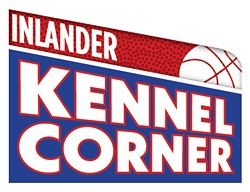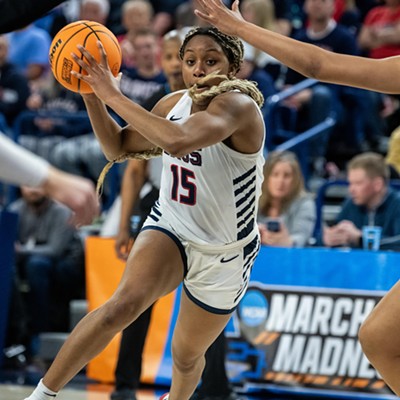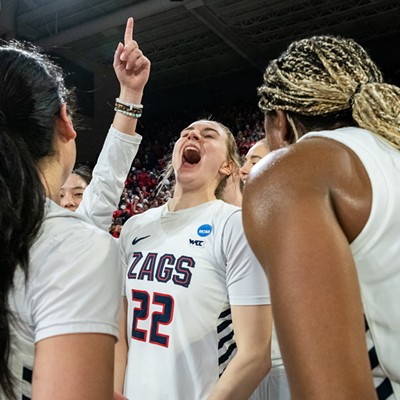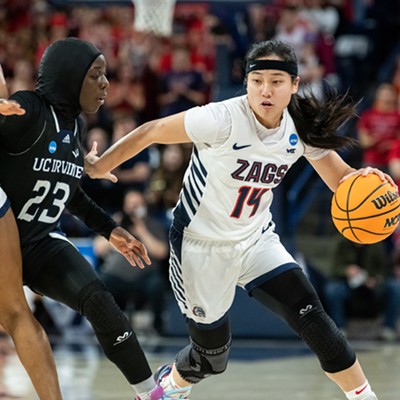RYAN NEMBHARD : JEREMY PARGO
Okay, the comp should probably come with the caveat of Ryan Nembhard being like a below-the-rim Jeremy Pargo. Because, for those of you too young to remember the Zag teams of the late-2000s, do a quick Google video search for “Jeremy Pargo dunk” and prepare to be entertained. Athleticism gap aside, this is about as clear of a comp as any. During his junior year in the 2008 season, Pargo averaged 12.1 points and 6 assists in 34 minutes per game. So far this year, Nembhard is averaging 12.5 points and 6 assists in 34 minutes per game. Pargo shot 26.5% from deep that year, preferring to do his scoring off the dribble. Nembhard is shooting 25% from deep this year, and also shows a penchant for attacking the paint. They’re both smaller guards, with Pargo’s listing of 6-foot-2 feeling a bit generous. Efficiency, by Gonzaga standards at least, is lacking with both. Despite that, each was given the keys to the offense and tasked with taking on by far the largest role in keeping the offense humming. An international journeyman, Pargo has made appearances for 19 professional teams including four stops in the NBA. Now 37 years old, Pargo currently plays in the NBA developmental league with the G-League Ignite team.NOLAN HICKMAN : JOSH PERKINS / GARY BELL
Nolan Hickman has been a lightning rod for criticism the past two seasons, much like Josh Perkins was for most of his Gonzaga career. Both are guards who were inversely forced to play out of their natural positions for a season, with Hickman moved to point guard last year and Perkins moved to shooting guard as a sophomore in 2017. Both did just fine in those roles, though for many, “just fine” wasn’t good enough. Often maligned for his decision making, Perkins nonetheless ended his career as the program’s all-time leader in assists. Hickman is also criticized for his decision making, despite the fact that Gonzaga’s offense during non-conference play was considerably more efficient with Hickman as the lead guard and Nembhard on the bench than it was with any combination of players around Nembhard. Hickman/Perkins is a perception comp, but a straight player comp for the Zag's current shooting guard would be Gary Bell. Hickman has the edge in scoring, with his 12.7 points per game this season being above Bell’s best of 11 per game as a junior. On the other hand, Bell has the edge defensively having won WCC Defensive POY honors as a senior, though Hickman has shown himself to be an above-average perimeter defender. Hickman has been asked to do more than Bell ever was, especially this season, so his efficiency numbers aren’t as good, but his volume is greater. Bell played for professional teams in Poland, France and Greece before returning to Gonzaga in 2019 as a graduate assistant. He is currently an assistant coach at Northern Arizona in the Big Sky Conference.DUSTY STROMER : KYLE DRANGINIS
This one was tough. I considered Mike Hart here for the non-scoring impact both he and Dusty Stromer have on the game, and I thought about Joel Ayayi for the well-rounded game both players have. The problem with both is that Stromer should eventually become a scorer for the Zags, which would ruin the Hart comp. But until he does become a scorer, the Ayayi comp doesn’t quite work. Even the Kyle Dranginis comp is a bit wonky, because Stromer was a day-one starter as a freshman (granted, that wouldn't have been the case if Steele Venters hadn't gotten injured) while Dranginis didn’t become a regular starter until his final year. Their career arcs will likely look quite different in the end, but for now Dusty’s best comp is Dranginis’ senior season. While he was the regular starter at the three guard spot in 2016, Dranginis was sixth on the team in scoring with 6.5 points per game. Stromer is now the regular starter at the three, but he’s seventh on the team at 6.4 points per game. Both have three point percentages in the mid-30s and a knack for grabbing over 4 rebounds per game. They contribute, but they don’t jump off the stat sheet. After graduation, Dranginis spent four seasons playing in Denmark and Germany.ANTON WATSON : ELIAS HARRIS
As I realized putting this together, when doing a career comp, you often need to toss aside players' freshman seasons. Anton Watson was a hometown kid with potential, but a recurring injury forced him to the bench and eventually onto the shelf for the second-half of his first season. Elias Harris was an international player and a relative unknown as a result — recruiting service 247sports doesn’t even list Harris on Gonzaga’s list of all-time signings — but he turned out to be a stud as a frosh.Both guys put together full careers in Spokane. Harris stayed for four seasons despite a breakout freshman campaign vaulting him into the NBA Draft discussion. Watson, thanks to the extra year of eligibility given because of the pandemic, is back for his fifth season as a Zag. Tailing off athletically a bit after his first year, Harris was never the team’s leading scorer for a season. Like Watson, he became a get-the-job-done sort of player. As upperclassmen, both were leaders by example as tough, smart and instinctive players. There’s also the statistical comparison to be made, and according to statistician Ken Pomeroy, the best comp for this season’s Anton Watson is junior year Elias Harris... and that’s not just among Zags. Pomeroy’s algorithm looks at every college basketball player from at least the past 15 seasons. And nobody has been more similar to Watson than Harris. Now 34, Harris had a short stint in the NBA as a rookie with the Lakers, but has since spent most of his career playing in his native Germany. He currently plays for EuroLeague club Bayern Munich.




















